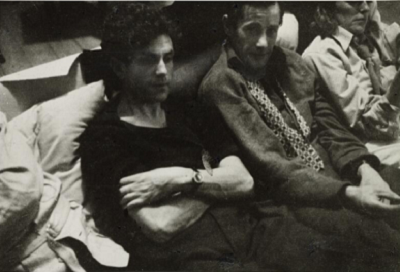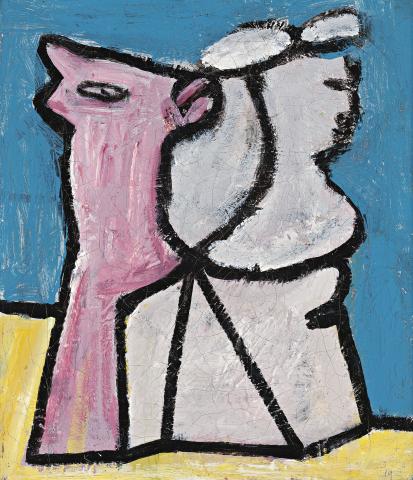GIRL ON HORSE, 1940
SIDNEY NOLAN
enamel paint on canvas
35.5 x 30.5 cm
inscribed lower right: 19
dated and inscribed with title verso on stretcher bar: GIRL ON HORSE 1940 / Newcastle No 7
John Hull, London
Gould collection, Melbourne
Sidney Nolan, Hatton Gallery, University of Durham, Newcastle-upon-Tyne, then touring to: Graves Art Gallery, Sheffield; Temple Newsam House, Leeds; Ferens Art Gallery, Hull; City Art Gallery, Bristol; Walker Art Gallery, Liverpool; Scottish Royal Academy, Edinburgh; City Art Gallery, Wakefield, 13 May – 28 November 1961, cat. 7
Sidney Nolan: Landscape and Legends, Gould Galleries, Melbourne, 7 March – 15 April 2001, and Gould Galleries, Sydney, 2 May – 3 June 2001, cat. 1 (illus. in exhibition catalogue)
Sidney Nolan: Myth and Country, Gould Galleries, Melbourne, 9 November – 4 December 2005, cat. 2 (illus. in exhibition catalogue)
Girl on Horse, 1941, enamel on canvas, 54.0 x 48.5 cm, private collection
12. Max Harris, John Reed, Sidney Nolan, Sunday Reed c1942.png

Sidney Nolan was the most famous Australian painter of the 20th century. Charismatic, well read and born with the gift of the gab (courtesy of an Irish heritage), he mixed freely with people from all walks of life including actors, royalty, arts personalities and academics yet maintained an enduring respect for his own working class origins. After his birth in Carlton, his tram-driver father moved the family to St Kilda when Nolan was two. This beachside suburb is a short distance from Melbourne and already had a raffish reputation as a place of relaxation and amusement, a ‘kitsch heaven’ … where he and his imagination could run wild.’1 Numerous dance halls, pavilions, movie houses and fun parlors dotted the area, all presided over by the grinning face, Moorish spires and scenic railway of Luna Park; and the delightful Girl on Horse, 1940 is an early celebration by Nolan of the area.
At fifteen, he commenced work as a junior learning the trade and techniques of commercial art before enrolling in classes at the National Gallery School, though he famously spent more time reading in the adjacent State Library. He then started producing small abstracts and collages which only attracted critical disdain and little public attention. Desperate to travel overseas, he approached the newspaper magnate Keith Murdoch for financial assistance in February 1938. Murdoch steered him instead to his art specialist Basil Burdett who, in turn, introduced Nolan to John Reed, resulting in of one of the most compelling and creative collaborations in Australian art history.
Ten months later Nolan married Elizabeth Paterson, and in 1940 the young couple moved into a rundown tenement studio opposite the Melbourne Museum in Russell Street. Importantly, its walls had been painted a ‘shocking pink’ by a previous tenant 2 and it is tempting to recognise this as the impetus for the numerous candy pink, blue and yellow paintings that tumbled from his brush over the next two years. Girl on Horse is an early member of this series and displays the strong influence of paintings from the 1920s and 30s by Picasso, Leger and Klee with ‘flat planes of bold colour separated by thick black lines.’3 Apart from the Russell Street location, Nolan temporarily shared a studio in St Kilda with John Sinclair. In between periods of painting, he spent many enjoyable hours watching horses being exercised in the shallow waters of the bay and this return to his childhood roots also triggered memories of fairgrounds. Significantly, Nolan had used a circus tent motif the previous year in his theatre designs for the ballet Icare presented by Colonel le Basil and Serge Lifar but the tent-like compression seen here in Girl on Horse is also informed by contemporary commercial art which was already ‘including cubistic fractured imagery, non-recessional space, abstracted line pattern and flat, bright colours.’4 Bold and assured (and painted on a preciously rare piece of war-time canvas), Girl on Horse remained in the artist’s possession for many years before passing to Nolan’s long-term English studio assistant John Hull. It is also the antecedent for a slightly larger version exhibited at the Contemporary Art Society, Melbourne, in 1941.
1. Nolan, S., 1977, quoted in: Underhill, N., Sidney Nolan: a life, NewSouth, Sydney, 2015, pp. 26 – 27.
2. See: Clarke, J., Sidney Nolan: Landscapes and Legends, National Gallery of Victoria, Melbourne, 1987, p. 16
3. Clark, J., op. cit., p. 37
4. Underhill, N., op. cit., p. 42
ANDREW GAYNOR
